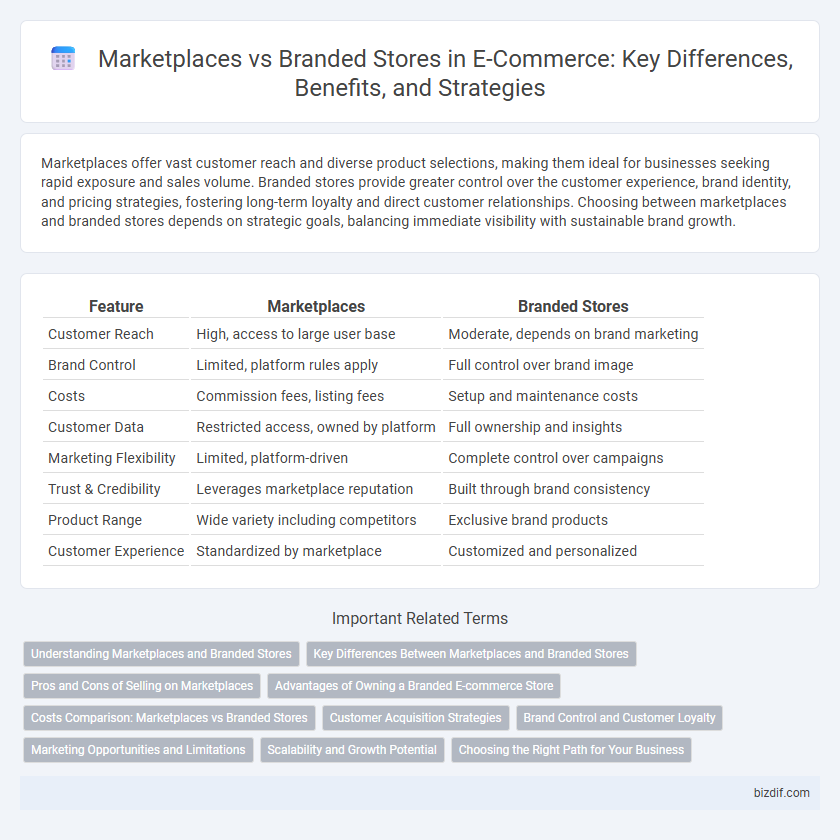Marketplaces offer vast customer reach and diverse product selections, making them ideal for businesses seeking rapid exposure and sales volume. Branded stores provide greater control over the customer experience, brand identity, and pricing strategies, fostering long-term loyalty and direct customer relationships. Choosing between marketplaces and branded stores depends on strategic goals, balancing immediate visibility with sustainable brand growth.
Table of Comparison
| Feature | Marketplaces | Branded Stores |
|---|---|---|
| Customer Reach | High, access to large user base | Moderate, depends on brand marketing |
| Brand Control | Limited, platform rules apply | Full control over brand image |
| Costs | Commission fees, listing fees | Setup and maintenance costs |
| Customer Data | Restricted access, owned by platform | Full ownership and insights |
| Marketing Flexibility | Limited, platform-driven | Complete control over campaigns |
| Trust & Credibility | Leverages marketplace reputation | Built through brand consistency |
| Product Range | Wide variety including competitors | Exclusive brand products |
| Customer Experience | Standardized by marketplace | Customized and personalized |
Understanding Marketplaces and Branded Stores
Marketplaces like Amazon and eBay aggregate multiple sellers, offering vast product variety and extensive customer reach, while branded stores focus on exclusive brand experience and direct customer relationships. Marketplaces benefit from high traffic and trust but often involve competition and commission fees, whereas branded stores provide control over branding, pricing, and customer data. Understanding these differences helps e-commerce businesses choose the optimal sales channel for growth and customer engagement.
Key Differences Between Marketplaces and Branded Stores
Marketplaces aggregate multiple third-party sellers, offering a wide product selection and higher traffic volume, while branded stores focus exclusively on their own products with full control over branding and customer experience. Marketplaces handle payment processing, shipping, and returns, reducing operational complexity for sellers, whereas branded stores require in-house management of these functions, enabling personalized service. Pricing is competitive and dynamic on marketplaces due to numerous sellers, while branded stores maintain consistent pricing aligned with brand strategy.
Pros and Cons of Selling on Marketplaces
Selling on marketplaces like Amazon, eBay, and Etsy offers access to a vast customer base and streamlined logistics, enhancing product visibility and accelerating sales velocity. However, marketplace sellers face challenges such as high commission fees, limited branding opportunities, and intense competition that can erode profit margins. The lack of direct customer relationships restricts personalized marketing efforts and data ownership, which are crucial for long-term brand building.
Advantages of Owning a Branded E-commerce Store
Owning a branded e-commerce store enhances customer loyalty by providing a unique brand experience tailored to targeted audiences, increasing repeat purchases and long-term value. It offers complete control over product presentation, pricing strategies, and marketing campaigns, allowing businesses to optimize conversions and maintain consistent brand messaging. With access to detailed customer data, branded stores enable personalized marketing and efficient inventory management, driving higher profit margins compared to selling on marketplaces.
Costs Comparison: Marketplaces vs Branded Stores
Marketplaces typically involve lower upfront costs due to shared platform expenses but charge higher commission fees ranging from 5% to 20% per sale, impacting overall profitability. Branded stores require significant investment in website development, marketing, and maintenance, yet maintain full control over pricing and customer data, potentially leading to higher long-term margins. Evaluating total cost of ownership and customer acquisition expenses is essential for businesses deciding between marketplace presence or exclusive branded store operation.
Customer Acquisition Strategies
Marketplaces leverage vast user bases and extensive product visibility, enabling rapid customer acquisition through search algorithms and cross-selling opportunities. Branded stores focus on personalized customer experiences, loyalty programs, and tailored marketing campaigns that foster brand trust and repeat purchases. Combining marketplace presence with a strong branded store strategy optimizes acquisition by capturing diverse customer segments and controlling brand narratives.
Brand Control and Customer Loyalty
Marketplaces offer vast customer reach but limit brand control through standardized layouts and policies, restricting personalized experiences that foster loyalty. Branded stores enable full control over brand presentation, messaging, and customer interaction, directly enhancing emotional connection and repeat business. Investing in a branded store strengthens customer loyalty through tailored experiences, exclusive offerings, and consistent brand voice, critical for long-term growth.
Marketing Opportunities and Limitations
Marketplaces offer access to a broad customer base and built-in traffic, providing extensive marketing opportunities through sponsored listings and customer reviews, but they limit brand control and differentiation. Branded stores enable full control over brand identity, customized customer experiences, and personalized marketing campaigns, yet they require significant investment in traffic acquisition and brand awareness strategies. Both channels require tailored approaches: marketplaces excel in volume and exposure, while branded stores drive loyalty and direct customer engagement.
Scalability and Growth Potential
Marketplaces offer rapid scalability by providing immediate access to a vast customer base and streamlined logistics, enabling sellers to quickly expand their reach without significant upfront investment. Branded stores, while slower to scale initially, allow businesses to build customer loyalty, control brand identity, and capture higher profit margins, fostering sustainable long-term growth. Strategic use of marketplaces alongside branded stores can maximize scalability and growth potential by balancing broad exposure with brand differentiation.
Choosing the Right Path for Your Business
Marketplaces offer extensive customer reach and simplified logistics, ideal for startups seeking rapid exposure and sales volume. Branded stores provide greater control over customer experience, brand identity, and data ownership, crucial for businesses focusing on long-term differentiation and loyalty. Evaluating your target audience, product niche, and growth strategy helps determine whether a marketplace or branded store aligns best with your business goals.
Marketplaces vs Branded stores Infographic

 bizdif.com
bizdif.com